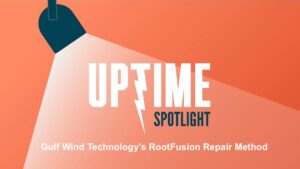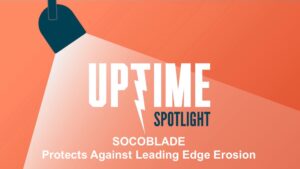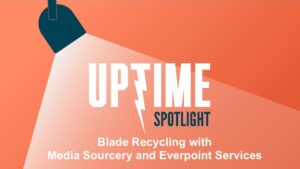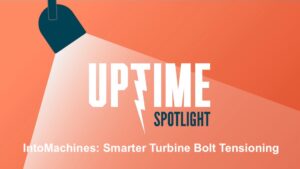Larry Ketchersid, CEO of Media Sourcery explains the company’s partnership with Everpoint Services to improve the process of recycling turbine blades and solar panels. Using blockchain technology to create verifiable proof of proper recycling, companies can get the processing and documentation they need – along with peace of mind.
Listen to the entire interview here
Wind and solar energy continue to expand worldwide, as more countries realize their tremendous potential, but a major blind spot looms: decommissioning renewable energy assets doesn’t always go according to plan. Wind turbine blade recycling has had some bad press lately, and solar panels, too, can disappear from job sites, only to reemerge in landfills, abandoned lots, or worse—dumped in unknown locations with no accountability. The problem undermines renewable energy by mocking its “green” label, and it threatens regulatory trust.
Enter Larry Ketchersid, CEO of Media Sourcery, and his collaboration with Everpoint Services, a renewable waste recycling company. Together, they’re leveraging blockchain and low-power IoT trackers to bring proof, transparency, and accountability to the renewable waste chain of custody.
Turbine Blade Recycling – Where’s the Accountability?
Despite increased public scrutiny, turbine blades and solar panels are frequently stockpiled rather than properly recycled. The renewable sector faces a critical perception issue: lack of verifiable documentation that assets are disposed of responsibly. Once a blade leaves a wind farm, how can operators—and regulators—be sure it reaches an approved recycler?
“You don’t know what people are doing with it. There’s a lot of dump sites where stuff gets put. It’s not the circular economy we’re trying to promote,” Ketchersid said in our interview.

Blockchain-Backed Proof of Recycling
Ketchersid explained that Media Sourcery’s system was originally developed to track the cold-chain integrity of COVID-19 test kits during the pandemic. Today, their platform tags and tracks renewable assets throughout their decommissioning lifecycle, from dismantling and transport to grinding and reuse.
Key elements include:
- Low-profile “sticker trackers”: Thin, GPS-enabled devices affixed to turbine blades or solar panel pallets. These send location data at defined intervals, and are cheap enough to destroy during grinding.
- Geofencing and smart rules: Trackers are idle while on-site to conserve battery; once assets leave the site or enter a recycling zone, they ping updates more frequently.
- Decentralized public ledgers: All tracking metadata is hashed and stored on the blockchain, ensuring tamper-proof documentation for regulators or stakeholders.
- NFT-backed verification: Upon completion of the recycling process, all lifecycle data can be minted into a non-fungible token (NFT), providing an immutable record of recycling proof, with potential carbon offset market value.
A Practical Use Case in Renewable Demolition
Everpoint Services integrates this tracking system into its demolition workflows. As part of one a recent project, 460 pallets of solar panels were fitted with sticker trackers. A shared dashboard visualized their movement from site to recycler, with geofences marking transition points, allowing operators, OEMs, or insurers to confirm in real-time that recycling actually occurred.
If a tracker went missing, fallback data from truck-mounted diagnostic trackers and GPS logs filled in the gaps—ensuring continuous verification.
From an accountability standpoint, “The goal is to provide as much evidence as possible.,” Ketchersid said. “We know what went on the truck. We know what got ground up. We know where and when it happened.”
The Next Challenge: Downstream Material Tracking
Currently, most tracking ends at grinding. But after that, companies want to be able to prove that blade shreds or panel fragments are being reused in construction materials or elsewhere – not quietly dumped.
Media Sourcery is exploring several solutions, including:
- Chemical fingerprinting: Originally tested in medical cannabis, a spray-on marker embeds a unique chemical signature into the material. It survives processing and can later be identified via spectrometry to trace final use.
- Vision AI at recyclers: Cameras with built-in machine learning monitor dials, shredders, and throughput, ensuring data integrity even when trackers are destroyed.
- Secondary tagging: Select Gaylord boxes or processed material bags can be tagged to verify downstream shipment and reuse.
Why Use Blockchain When Recycling Turbine Blades?
Storing this lifecycle data on the blockchain offers two vital benefits:
- Immutability: Once hashed and stored, data can’t be altered—critical for regulatory proof or insurance audits.
- Tokenization: NFTs created from the recycling data can later represent carbon offset credits, enabling participation in voluntary carbon markets.
Ketchersid’s team is working with DOE labs like Oak Ridge and Sandia to validate the full greenhouse gas (GHG) savings from verified recycling, potentially linking these NFTs to measurable Scope 3 emissions reductions.
Can Blockchain Proves that Wind Energy is Truly Green?
More than solving a waste problem, “We’re trying to promote a circular economy,” Ketchersid said. “This technology is how we make that real.”
Transparent, verifiable recycling builds trust with regulators, communities, and investors. And with the rise of carbon markets and ESG reporting, proof of authenticity isn’t just helpful; it’s becoming necessary.
Additional resources:
See working demos of wind turbine blade recycling and other projects and learn about blockchain-backed recycling tracking at https://proofofauthenticity.net
More in the Podcast: Applications Beyond Renewables
While wind and solar are the current focus, – Ketchersid said the potential extends to tracing balsa wood in turbine blades, ensuring sustainable sourcing, or verifying bio-based composites – in addition to green energy, Media Sourcery has applied similar techniques to:
- Medical cold-chain verification
- Medical cannabis provenance
- Capped well methane emissions tracking
- Verification of international carbon credit legitimacy






